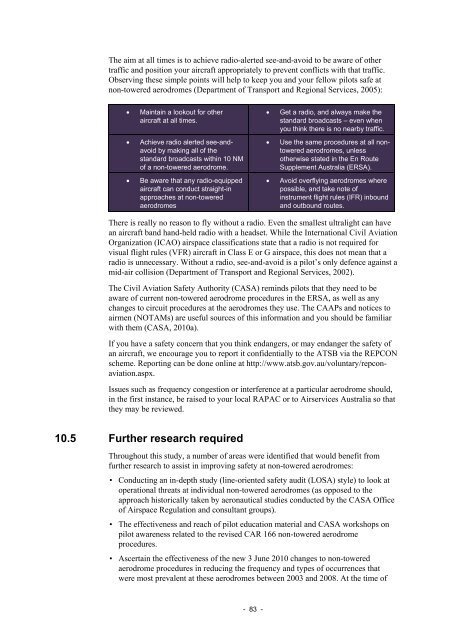Safety in the vicinity of non-towered aerodromes - Australian ...
Safety in the vicinity of non-towered aerodromes - Australian ...
Safety in the vicinity of non-towered aerodromes - Australian ...
Create successful ePaper yourself
Turn your PDF publications into a flip-book with our unique Google optimized e-Paper software.
The aim at all times is to achieve radio-alerted see-and-avoid to be aware <strong>of</strong> o<strong>the</strong>r<br />
traffic and position your aircraft appropriately to prevent conflicts with that traffic.<br />
Observ<strong>in</strong>g <strong>the</strong>se simple po<strong>in</strong>ts will help to keep you and your fellow pilots safe at<br />
<strong>non</strong>-<strong>towered</strong> <strong>aerodromes</strong> (Department <strong>of</strong> Transport and Regional Services, 2005):<br />
• Ma<strong>in</strong>ta<strong>in</strong> a lookout for o<strong>the</strong>r<br />
aircraft at all times.<br />
• Achieve radio alerted see-andavoid<br />
by mak<strong>in</strong>g all <strong>of</strong> <strong>the</strong><br />
standard broadcasts with<strong>in</strong> 10 NM<br />
<strong>of</strong> a <strong>non</strong>-<strong>towered</strong> aerodrome.<br />
• Be aware that any radio-equipped<br />
aircraft can conduct straight-<strong>in</strong><br />
approaches at <strong>non</strong>-<strong>towered</strong><br />
<strong>aerodromes</strong><br />
• Get a radio, and always make <strong>the</strong><br />
standard broadcasts – even when<br />
you th<strong>in</strong>k <strong>the</strong>re is no nearby traffic.<br />
• Use <strong>the</strong> same procedures at all <strong>non</strong><strong>towered</strong><br />
<strong>aerodromes</strong>, unless<br />
o<strong>the</strong>rwise stated <strong>in</strong> <strong>the</strong> En Route<br />
Supplement Australia (ERSA).<br />
• Avoid overfly<strong>in</strong>g <strong>aerodromes</strong> where<br />
possible, and take note <strong>of</strong><br />
<strong>in</strong>strument flight rules (IFR) <strong>in</strong>bound<br />
and outbound routes.<br />
There is really no reason to fly without a radio. Even <strong>the</strong> smallest ultralight can have<br />
an aircraft band hand-held radio with a headset. While <strong>the</strong> International Civil Aviation<br />
Organization (ICAO) airspace classifications state that a radio is not required for<br />
visual flight rules (VFR) aircraft <strong>in</strong> Class E or G airspace, this does not mean that a<br />
radio is unnecessary. Without a radio, see-and-avoid is a pilot’s only defence aga<strong>in</strong>st a<br />
mid-air collision (Department <strong>of</strong> Transport and Regional Services, 2002).<br />
The Civil Aviation <strong>Safety</strong> Authority (CASA) rem<strong>in</strong>ds pilots that <strong>the</strong>y need to be<br />
aware <strong>of</strong> current <strong>non</strong>-<strong>towered</strong> aerodrome procedures <strong>in</strong> <strong>the</strong> ERSA, as well as any<br />
changes to circuit procedures at <strong>the</strong> <strong>aerodromes</strong> <strong>the</strong>y use. The CAAPs and notices to<br />
airmen (NOTAMs) are useful sources <strong>of</strong> this <strong>in</strong>formation and you should be familiar<br />
with <strong>the</strong>m (CASA, 2010a).<br />
If you have a safety concern that you th<strong>in</strong>k endangers, or may endanger <strong>the</strong> safety <strong>of</strong><br />
an aircraft, we encourage you to report it confidentially to <strong>the</strong> ATSB via <strong>the</strong> REPCON<br />
scheme. Report<strong>in</strong>g can be done onl<strong>in</strong>e at http://www.atsb.gov.au/voluntary/repconaviation.aspx.<br />
Issues such as frequency congestion or <strong>in</strong>terference at a particular aerodrome should,<br />
<strong>in</strong> <strong>the</strong> first <strong>in</strong>stance, be raised to your local RAPAC or to Airservices Australia so that<br />
<strong>the</strong>y may be reviewed.<br />
10.5 Fur<strong>the</strong>r research required<br />
Throughout this study, a number <strong>of</strong> areas were identified that would benefit from<br />
fur<strong>the</strong>r research to assist <strong>in</strong> improv<strong>in</strong>g safety at <strong>non</strong>-<strong>towered</strong> <strong>aerodromes</strong>:<br />
• Conduct<strong>in</strong>g an <strong>in</strong>-depth study (l<strong>in</strong>e-oriented safety audit (LOSA) style) to look at<br />
operational threats at <strong>in</strong>dividual <strong>non</strong>-<strong>towered</strong> <strong>aerodromes</strong> (as opposed to <strong>the</strong><br />
approach historically taken by aeronautical studies conducted by <strong>the</strong> CASA Office<br />
<strong>of</strong> Airspace Regulation and consultant groups).<br />
• The effectiveness and reach <strong>of</strong> pilot education material and CASA workshops on<br />
pilot awareness related to <strong>the</strong> revised CAR 166 <strong>non</strong>-<strong>towered</strong> aerodrome<br />
procedures.<br />
• Ascerta<strong>in</strong> <strong>the</strong> effectiveness <strong>of</strong> <strong>the</strong> new 3 June 2010 changes to <strong>non</strong>-<strong>towered</strong><br />
aerodrome procedures <strong>in</strong> reduc<strong>in</strong>g <strong>the</strong> frequency and types <strong>of</strong> occurrences that<br />
were most prevalent at <strong>the</strong>se <strong>aerodromes</strong> between 2003 and 2008. At <strong>the</strong> time <strong>of</strong><br />
- 83 -
















